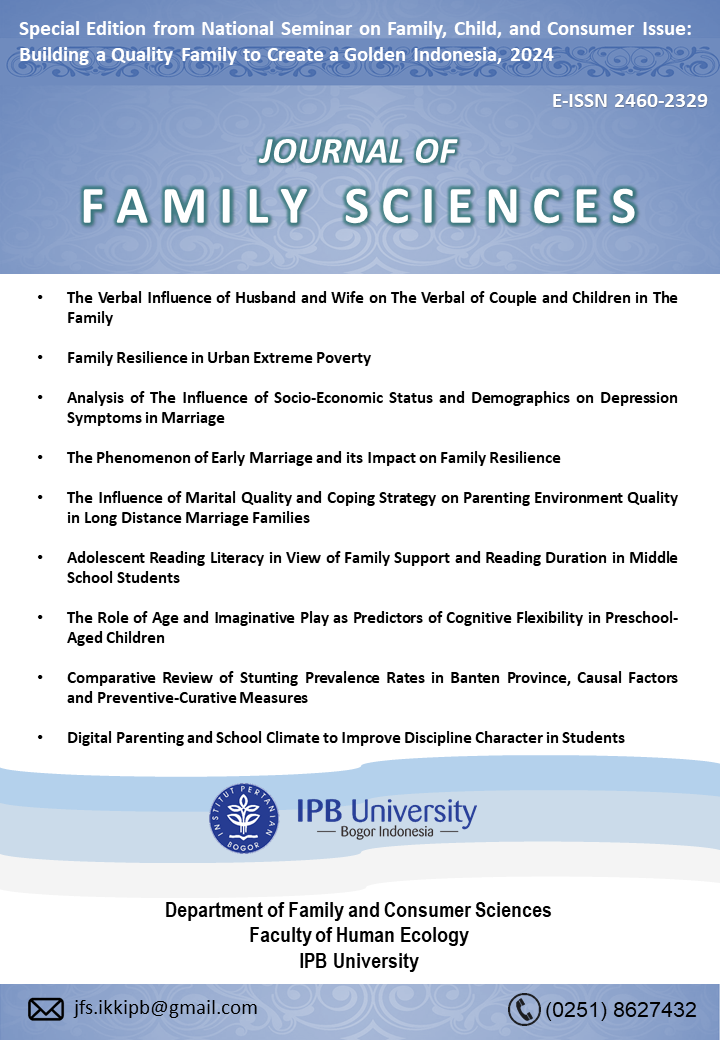Family Resilience in Urban Extreme Poverty
Abstract
The impact of poverty causes pressure that weakens family resilience. Although measurements of family resilience are available, there are not many up-to-date measures for urban poor families in Indonesia. The purpose of this study is to describe the profile of family resilience and the conditions of vulnerability of extreme urban poor families. The research subjects were the heads of families (N=416) spread across five sub-districts in the city of Bandung, with the highest number of poverties, where most of the subjects worked as daily laborers. The measurement uses a scale of family resilience through four dimensions: the quality of physical, economic, psychological, social, and family structure as demographic resilience. Data were analyzed with descriptive and correlational statistics using JASP 0.15. The results show that poor families have a level of fulfillment of family resilience qualities of 16.5 percent (12.62 percent on the dimensions of physical endurance, 12.46 percent on the economic dimension, 17.33 percent on the psychological dimension and 19.95 percent on the social dimension). Several dimensions have a significant positive relationship, with the highest level on the relationship between dimensions of physical and economic resilience (r=.768). Six conditions of vulnerability were found, namely related to job instability and income that is less than needed, environmental cleanliness and insufficient food consumption, misunderstanding of family goals, and lack of gratitude for conditions. The research findings show two sub-dimensions in each dimension of social resilience and psychological resilience. Suggestions and implications are directed at recommendations for urban extreme poverty alleviation programs and optimizing family quality programs, especially aspects of independence.
Downloads
References
Amalia, L., & Samputra, P. L. (2020). Strategi ketahanan ekonomi keluarga miskin penerima dana bantuan sosial di Kelurahan Tanah Tinggi Jakarta Pusat. Jurnal SOSIO KONSEPSIA, 9(2). https://doi.org/10.33007/ska.v9i2.1792
Annur, R. (2013). Faktor-faktor yang mempengaruhi kemiskinan di Kecamatan Jekulo dan Mejobo Kabupaten Kudus Tahun 2013. Economics Development Analysis Journal, 2(4). https://doi.org/10.15294/Edaj.V2i4.3209
Antika, A. (2018). Studi Komparasi Ketahanan Keluarga Antara Keluarga Penerima Dan Bukan Penerima Program Keluarga Harapan (PKH).
Aulia, R., Ridho, M., & Rapli, A. (2018). Ketahanan keluarga: tinjauan kebersamaan keluarga menghadapi tekanan perekonomian di Kota Jambi. Khazanah Intelektual, 2(3), 333-340. https://doi.org/10.37250/newkiki.v2i3.32
Baxter, L. A. (2014). Theorizing The Communicative Construction Of “Family”:The Threer’s. In L. A. Baxter Ed., Remaking “Family” Communicatively. New York (US): Peter Lang
Blum, Hendrik L. (1974). Planning For Health, Development And Aplication Of Social Changes Theory. New York (US): Human Sciences Press.
Burgess, A. F., & Gutstein, S. E. (2005). Quality of life for people with autism: raising the standard for evaluating successful outcomes. Child And Adolescent Mental Health, 12(2), 80-86. https://doi.org/10.1111/j.1475-3588.2006.00432.x
Ermawati, R.O.(2011). Analisis ketahanan pangan rumah tangga miskin pada daerah rawan banjir di Kecamatan Jebres Kota Surakarta. Skripsi. Fakultas Pertanian. Surakarta : Universitas Sebelas Maret
Fathurrizqi, M. I. (2020). Hubungan tingkat kesejahteraan dan ketahanan keluarga: kasus keluarga fertilitas rendah di Kecamatan Panggang Gunungkidul (Doctoral Dissertation, Universitas Gadjah Mada).
Fitzpatrick, M. A., & Ritchie, L. D. (1994). Communication schemata within the family: multiple perspectives on family interaction. Human Communication Research, 20, 275–301. https://doi.org/10.1111/j.1468-2958.1994.tb00324.x
Folkman, S., & Moskowitz, J. T. (2000). Positive affect and theother side of coping. American Psychologist, 55(6),647–654. https://doi.org/10.1037/0003-066X.55.6.647
Fortini, R. M., Teixeira, E. C., Silveira, S. D. F., & Moreira, V. D. S. (2019). Measurement of rural multidimensional poverty in the Northern and Jequitinhonha Mesoregions of Minas Gerais. Revista de Economia e Sociologia Rural, 57(1), 161-180. https://doi.org/10.1590/1234-56781806-94790570110
Fowler, F. (2013). Survey Research Methods (5th Edition). Los Angeles (US): Sage Publication
Harper, L. J, Deaton, B. J, & Driskel, J. A (1985). Pangan, Gizi Dan Pertanian. Jakarta (ID): UI Press
Hasanah, V. R., & Komariah, D. N. (2019). MOTEKAR (Motivator Ketahanan Keluarga) Dan Pemberdayaan Keluarga Rentan. PAUD Lectura: Jurnal Pendidikan Anak Usia Dini, 2(02), 42-56. https://doi.org/10.31849/paud-lectura.v2i02.2519
Herawati, T., Ginting, B., Asngari, P. S., Susanto, D., & Puspitawati, H. (2011). Ketahanan pangan keluarga peserta program pemberdayaan masyarakat di pedesaan. Jurnal Gizi dan Pangan, 6(3), 208-216.
Iskandar, H., Sumarwan, U., & Khomsan, A. (2010). Faktor-faktor yang mempengaruhi kesejahteraan keluarga. Kesehatan Masyarakat, 1, 133-141.
Isnaeni, I., & Ayubi, D. (2021). Gambaran ketahanan keluarga disabilitas di masa pandemi COVID-19. Media Publikasi Promosi Kesehatan Indonesia (MPPKI), 4(4), 507-516. https://doi.org/10.56338/mppki.v4i4.1758
Istiono, W. W., Suryadi, H., & Haris, M. (2009). Analisis faktor-faktor yang mempengaruhi status gizi balita. Berita Kedokteran Masyarakat, 25(3), 150. Retrieved from https://download.garuda.kemdikbud.go.id/article.php?article=2980017&val=26728&title=Analisis%20Faktor-Faktor%20yang%20Mempengaruhi%20Status%20Gizi%20Balita
Lestari, W. (2020). Ketahanan Keluarga Pasca Graduasi Dari Program Keluarga Harapan (Studi Kasus Keluarga Penerima Manfaat PKH Sukoharjo, Jawa Tengah, Indonesia) (Doctoral Dissertation, UNS (Sebelas Maret University)).
Maryono, E. (1999). Peta Dampak Krisis dan Kapasitas Masyarakat. Penerbit Jari IndonesiaMasyarakat Sipil untuk Transparansi dan Akuntabilitas Pembangunan. Jakarta.
McCubbin, H. I., & McCubbin, M. A. (1988). Typologies of resilient families: Emerging roles of social class and ethnicity. Family Relations, 247-254. https://doi.org/10.2307/584557
McCubbin, M. A., & McCubbin, H. I. (1996). Resiliency in families: A conceptual model of family adjustment and adaptation in response to stress and crises. Family assessment: Resiliency, coping and adaptation: Inventories for research and practice, 1-64.
McLoyd, V. C. (1998). Socioeconomic disadvantage and child development. American psychologist, 53(2), 185-204. https://psycnet.apa.org/doi/10.1037/0003-066X.53.2.185
Megawanty, R., & Hanita, M. (2021). Ketahanan keluarga dalam adaptasi new normal pandemi COVID-19 di Indonesia. Jurnal Lemhannas RI, 9(1), 42-54. https://doi.org/10.55960/jlri.v9i1.375
Muzakkir, I. (2017). Penerapan metode topsis untuk sistem pendukung keputusan penentuan keluarga miskin pada desa Panca Karsa Ii. ILKOM Jurnal Ilmiah, 9(3), 274-281. https://doi.org/10.33096/ilkom.v9i3.156.274-281
Nursyif, A. (2020) Rancangan undang-undang ketahanan keluarga dalam perspektif sosiologi gender. Journal of Civics And Education Studies. 7, 58. https://doi.org/10.32493/jpkn.v7i1.y2020.p55-68
O’Leary, Z. (2014). The Essential Guide To Doing Your Research Project (2nd Ed.). London (ID): SAGE.
Okech, D., Howard, W. J., Mauldin, T., Mimura, Y., & Kim, J. (2012). The effects of economic pressure on the resilience and strengths of individuals living in extreme poverty. Journal of Poverty, 16(4), 429-446. https://doi.org/10.1080/10875549.2012.720659
Pessoa, A. S. G., Coimbra, R. M., Koller, S. H., & Ungar, M. (2019). Hidden resilience in the life of adolescents with involvement in drug trafficking. Psicologia: Teoria e Pesquisa, 34. https://doi.org/10.1590/0102.3772e34426
Puspitawati, H., Herawati, T., & Rahma, A. (2016). Telaah pengintegrasian perspektif gender dalam keluarga untuk mewujudkan kesetaraan dan keadilan gender dan ketahanan keluarga di Provinsi Jawa Timur dan Sumatera Utara.
Qomariah, D. N. (2018). Studi Analisis Tentang Peran Dan Fungsi Motekar Dalam Meningkatkan Ketahanan Keluarga (Kasus Pada Masyarakat Miskin Perkotaan Di Kota Bandung) (Doctoral Dissertation, Universitas Pendidikan Indonesia)
Ramadhana, M. R. (2020). Mempersiapkan ketahanan keluarga selama adaptasi kebiasaan baru di masa pandemi Covid-19. Jurnal Kependudukan Indonesia, 61-68. https://doi.org/10.14203/jki.v0i0.572
Rizki, M. N. (2017). Pengaruh Implementasi Program Keluarga Harapan (Pkh) Terhadap Ketahanan Keluarga Di Kelurahan Jakasampurna (Doctoral Dissertation, Universitas Negeri Jakarta).
Seccombe, K. (2000). Families in poverty in the 1990s: Trends, causes, consequences, and lessons learned. Journal of Marriage and Family, 62(4), 1094-1113. https://doi.org/10.1111/j.1741-3737.2000.01094.x
Sholihah, F., Susanti, E., & Mas'Udah, S. (2023). Pengaruh status sosial ekonomi keluarga dan dukungan sosial terhadap ketahanan keluarga penyintas Covid-19. Jurnal Litbang: Media Informasi Penelitian, Pengembangan Dan IPTEK, 19(1), 73-84. https://doi.org/10.33658/jl.v19i1.319
Wahyudi, T. W. (2020). Ketahanan Pangan Masyarakat Miskin Di Kecamatan Cimanggung (Doctoral Dissertation, Universitas Pendidikan Indonesia).
Walsh, F. (2006). Strengthening Family Resilience (2nd Ed., 384 P.). New York: Guilford Press.
Wulandari, N., Indrianti, D. T., & Hilmi, M. I. (2022). Analisis gender peran perempuan pesisir pada ketahanan keluarga di desa Puger Kulon Kabupaten Jember. Jendela PLS: Jurnal Cendekiawan Ilmiah Pendidikan Luar Sekolah, 7(1), 52-60.
Copyright (c) 2024 Journal of Family Sciences

This work is licensed under a Creative Commons Attribution 4.0 International License.
Authors who publish with this journal agree to the following terms:
- Authors retain copyright and grant the journal right of first publication with the work simultaneously licensed under

This work is licensed under a Creative Commons Attribution 4.0 International License. that allows others to share the work with an acknowledgement of the work's authorship and initial publication in this journal. - Authors are able to enter into separate, additional contractual arrangements for the non-exclusive distribution of the journal's published version of the work (e.g., post it to an institutional repository or publish it in a book), with an acknowledgement of its initial publication in this journal.
- Authors are permitted and encouraged to post their work online (e.g., in institutional repositories or on their website) prior to and during the submission process, as it can lead to productive exchanges, as well as earlier and greater citation of published work (See The Effect of Open Access).



_001.png)



